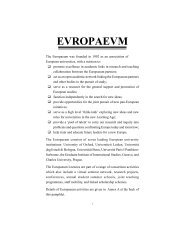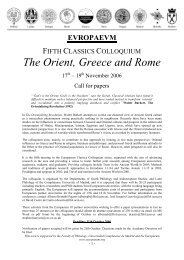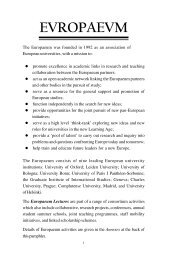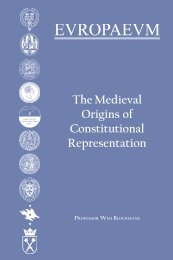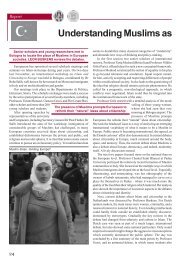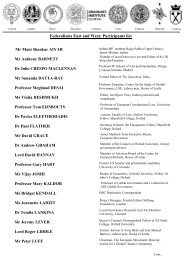Authors Iain Begg | Gabriel Glöckler | Anke Hassel ... - The Europaeum
Authors Iain Begg | Gabriel Glöckler | Anke Hassel ... - The Europaeum
Authors Iain Begg | Gabriel Glöckler | Anke Hassel ... - The Europaeum
Create successful ePaper yourself
Turn your PDF publications into a flip-book with our unique Google optimized e-Paper software.
eduction in rates of unemployment and a notable increase in employment<br />
rates. However, a trade-off between employment and productivity growth<br />
has been noteworthy, though it has been most pronounced in member<br />
states experiencing stronger employment growth and more frequently<br />
observed in low-growth “old Europe” than in fast-growing “new Europe”.<br />
Obviously, those developments have been causally related to reforms that<br />
have, especially since the mid-1990s, been implemented in European<br />
labour markets. 30 Yet, despite their increased pace and frequency, those<br />
reforms have seldom been comprehensive. Instead, they have been largely<br />
marginal in scope and scale. <strong>The</strong>y have also encompassed measures almost<br />
equally split between those reducing levels of protection and those<br />
providing for increased protection, whilst occasionally comprising<br />
contradictory policies undoing one another over a short period of time. 31<br />
In particular, marginal reforms have often only entailed partial relaxation<br />
of employment rules, leaving the entitlements of those already employed<br />
under permanent contracts virtually untouched, hence resulting in twotier<br />
labour market institutions and dual labour markets. <strong>The</strong>refore, strong<br />
rises in the shares of so-called flexible forms of employment, especially<br />
fixed-term employment and temporary agency work, have been observed<br />
in several EU member states. Consequently, the frequency of low-wage<br />
employment has increased, along with an increase in volatile employment<br />
and lack of training for those working under flexible job contracts, thereby<br />
negatively affecting labour productivity. 32<br />
Reforms, furthermore, have also involved changes in active labour market<br />
policies, unemployment benefits and labour taxation, regular employment<br />
protection and wage-setting institutions. However there has been little<br />
change to early retirement policies. 33 Interestingly, the implementation of<br />
labour market reforms has not proven to be easier amidst weak economic<br />
conditions associated with a higher risk of job losses, whilst comprehensive<br />
supply-friendly labour market reforms have seldom been carried out<br />
under unfavourable economic conditions. 34 <strong>The</strong>refore, one may doubt<br />
that the current severe economic crisis may, in itself, allow for the<br />
implementation of comprehensive reforms.<br />
<strong>The</strong> need for comprehensive reform of labour market regulations has<br />
probably been made clear. It has also been formally acknowledged by<br />
national governments. Indeed, the Council of the EU has called for a<br />
“sustained reform effort”, inter alia conceding that only limited progress<br />
has been achieved with respect to reform of employment protection<br />
legislation and pointing to the need for reforms that improve work<br />
Chapter 6 – Nikos Koutsiaras 97




